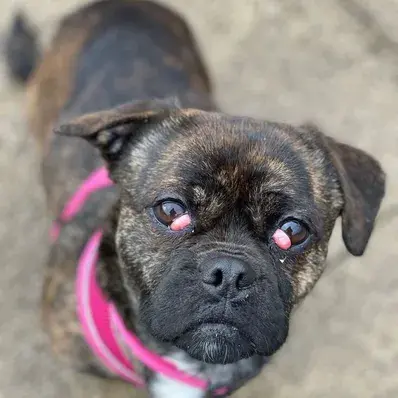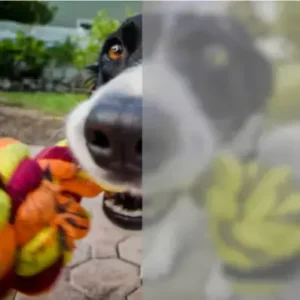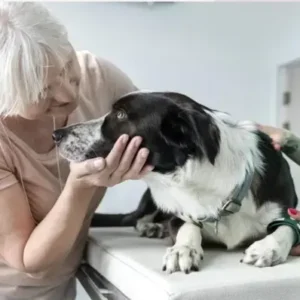Symptoms of Cherry Eye
The most common signs of cherry eye in dogs include:
- Swelling and protrusion of the gland: A noticeable, reddish lump that appears in the corner of the dog’s eye.
- Redness and irritation: The eye may look inflamed or irritated.
- Excessive watering or discharge: Affected dogs may have watery eyes or a mucous-like discharge.
- Squinting or rubbing the eyes: Your dog may seem uncomfortable and frequently paw at or rub their eyes.
If these symptoms are noticed, it is important to get your dog diagnosed by a vet to determine if cherry eye in dogs requires surgery or other treatments.
Causes of Cherry Eye
Cherry eye is one of the dog eye health issues that primarily results from a weakness in the connective tissue that holds the third eyelid gland in place.
Some of the most common causes include:
- Genetic predisposition: Certain breeds, such as Bulldogs, Cocker Spaniels, and Shih Tzus, are more likely to develop cherry eye due to inherited traits.
- Age-related factors: Older dogs may experience weakened connective tissue, which can make them more susceptible to cherry eye.
- Injury or stress: Trauma to the eye area can sometimes trigger the condition.
Cherry eye is most common in:
- English Bulldog
- French Bulldog
- Great Dane
- Cane Corso
- Chinese Shar-Pei
- Lhasa Apsos
Diagnosing Cherry Eye
If you suspect your dog has a cherry eye, a visit to the vet is necessary. The vet will conduct a thorough eye exam, assess the gland’s position, and rule out other conditions that may cause similar symptoms.
Cherry eye is generally easy to diagnose based on its appearance, but in some cases, further tests may be needed to check for secondary infections or complications. If diagnosed, your vet may recommend surgery or other treatments, such as eye drops for cherry eye.
Treatment Options for Cherry Eye in Dogs
Treatment for cherry eye in dogs depends on the severity of the condition:
- Non-surgical treatment: In some cases, your vet may recommend eye drops to reduce inflammation and irritation. However, this is often a temporary solution and may not fully resolve the problem.
- Surgical treatment: Cherry eye requires surgery. A common procedure involves repositioning the gland back into place. This can be done through a gland repositioning surgery. This was later found to increase the risk of the patient developing keratoconjunctivitis sicca, which can develop dry eye.
- Aftercare following surgery: After the surgery, your dog will need monitoring, and you may need to apply prescribed eye drops or ointments. Post-surgical care and follow-up visits are essential to ensure proper healing and prevent the cherry eye in dogs.
Massage and Home Treatment for Cherry Eye in Dogs
Some owners wonder if there are home treatments for cherry eye in dogs, including the use of gentle massage to try and reduce swelling. However, while some mild cases may benefit from moistening the eye or using natural remedies.
A vet will provide advice on whether any at-home options, such as eye drops, could help with minor inflammation before the need for surgical intervention.
Can Cherry Eye in Dogs Go Away on Its Own?
In some cases, cherry eye in dogs may seem to resolve on its own, especially if it is mild. However, this is not always the case, and recurrence is common. It’s crucial to understand that while the swelling might temporarily decrease, the underlying issue—weakness in the connective tissue—remains.
Cost of Cherry Eye Treatment in Dogs
The cost of cherry eye treatment in dogs can vary depending on the type of treatment chosen. Surgery typically ranges from $300 to $1,000, depending on the complexity and location of the procedure. Non-surgical treatments, such as eye drops, are usually less expensive but may not be as effective in the long term.
When to See a Board-Certified Veterinary Ophthalmologist
If you notice signs of cherry eye in dogs, it is important to visit a vet. Early intervention can prevent complications and the need for more invasive treatments later on. Whether the condition requires eye drops, massage, or surgery for cherry eye in dogs, your vet will guide you through the best course of action.








